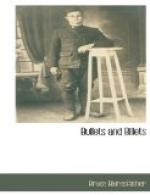On this first night, not being very familiar with the neighbourhood, I found it difficult to ignore the weird noises which floated in through the sack-covered hole. There is something very eerie and strange about echoing rifle shots in the silence of the night. Once I got up and walked out into the courtyard of the farm, and passing through it came out on to the end of the road. All as still as still could be, except the distant intermittent cracking of the rifles coming from away across the plain, beyond the long straight row of lofty poplar trees which marked the road. A silence of some length might supervene, in which one would only hear the gentle rustling of the leaves; then suddenly, far away on the right, a faint surging roar can be heard, and then louder and louder. “Wind up over there.” Then, gradually, silence would assert itself once more and leave you with nothing but the rustling leaves and the crack of the sniper’s rifle on the Messines ridge.
My first morning at this farm was, by special request, to be spent in decorating the walls.
There wasn’t much for anyone to do in the day time, as nobody could go out. The same complaint as the other place in St. Yvon: “We mustn’t look as if anyone lives in the farm.” Drawing, therefore, was a great aid to me in passing the day. Whilst at breakfast I made a casual examination of the room where we had our meals. I was not the first to draw on the walls of that room. Some one in a previous battalion had already put three or four sketches on various parts of the fire-place. Several large spaces remained all round the room, however; but I noticed that the surface was very poor compared with the wall round the fire-place.
The main surface was a rough sort of thing, and, on regarding it closely, it looked as if it was made of frozen porridge, being slightly rough, and of a grey-brown colour. I didn’t know what on earth I could use to draw on this surface, but after breakfast I started to scheme out something. I went into the back room, which we were now using as a kitchen, and finding some charcoal I tried that. It was quite useless—wouldn’t make a mark on the wall at all. Why, I don’t know; but the charcoal just glided about and merely seemed to make dents and scratches on the “frozen porridge.” I then tried to make up a mixture. It occurred to me that possibly soot might be made into a sort of ink, and used with a paint brush. I tried this, but drew a blank again. I was bordering on despair, when my servant said he thought he had put a bottle of Indian ink in my pack when we left to come into the trenches this time. He had a look, and found that his conjecture was right; he had got a bottle of Indian ink and a few brushes, as he thought I might want to draw something, so had equipped the pack accordingly.
I now started my fresco act on the walls of the Douve farm.
I spent most of the day on the job, and discovered how some startling effects could be produced.




